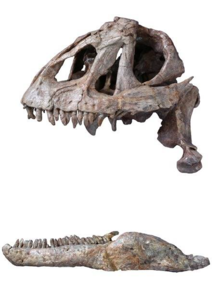
Mamenchisaurus is a genus of sauropod dinosaur known for their remarkably long necks which made up nearly half the total body length. Numerous species have been assigned to the genus; however, the validity of these assignments has been questioned. Fossils have been found in the Sichuan Basin and Yunnan Province in China. Several species from the Upper Shaximiao Formation, whose geologic age is uncertain, have been described. However, evidence suggests this formation to be no earlier than the Oxfordian stage of the Late Jurassic. M. sinocanadorum dates to the Oxfordian stage, and M. anyuensis to the Aptian stage of the Early Cretaceous. Most species were medium-large to large sauropods, measuring roughly 15 to 26 meters in length—possibly up to 35 meters (115 ft), based on two undescribed vertebrae.

Lufengosaurus is a genus of massospondylid dinosaur which lived during the Early Jurassic period in what is now southwestern China.

Shunosaurus, meaning "Lizard from Sichuan", is a genus of sauropod dinosaur from Late Jurassic (Oxfordian) beds in Sichuan Province in China, from 161 to 157 Million years ago. The name derives from "Shu", an ancient name for the Sichuan province.
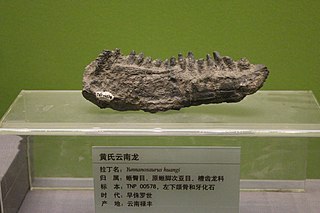
Yunnanosaurus is an extinct genus of sauropodomorph dinosaur that lived approximately 199 to 183 million years ago in what is now the Yunnan Province, in China, for which it was named. Yunnanosaurus was a large sized, moderately-built, ground-dwelling, quadrupedal herbivore, that could also walk bipedally, and ranged in size from 7 meters (23 feet) long and 2 m (6.5 ft) high to 4 m (13 ft) high in the largest species.
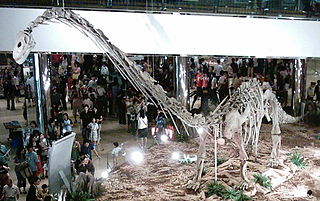
Omeisaurus is a genus of sauropod dinosaur from the Middle Jurassic Period of what is now China. Its name comes from Mount Emei, where it was discovered in the lower Shaximiao Formation of Sichuan Province.
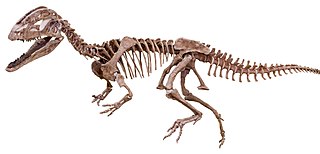
Sinosaurus is an extinct genus of theropod dinosaur which lived during the Early Jurassic Period. It was a bipedal carnivore approximately 5.5 metres (18 ft) in length and 300 kilograms (660 lb) in body mass. Fossils of the animal were found at the Lufeng Formation, in the Yunnan Province of China.

Gyposaurus is a genus of basal sauropodomorph dinosaur from the early Jurassic of South Africa. It is usually considered to represent juveniles of other prosauropods, but "G." sinensis is regarded as a possibly valid species.

Chienkosaurus is a dubious genus of carnivorous theropod dinosaur from the Late Jurassic Kuangyuan Series of China. It was probably related to Szechuanosaurus.
Chinshakiangosaurus is a genus of dinosaur and probably one of the most basal sauropods known. The only species, Chinshakiangosaurus chunghoensis, is known from a fragmentary skeleton found in Lower Jurassic rocks in China. Chinshakiangosaurus is one of the few basal sauropods with preserved skull bones and therefore important for the understanding of the early evolution of this group. It shows that early sauropods may have possessed fleshy cheeks.
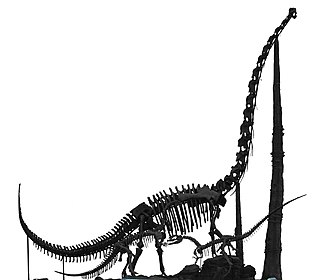
Chuanjiesaurus is a genus of sauropod dinosaurs from the middle Jurassic Period. They lived in what is now China. The type species, Chuanjiesaurus anaensis, was first described by Fang, Pang, Lü, Zhang, Pan, Wang, Li and Cheng in 2000. Fossils of the species were found in the village of Chuanjie, Lufeng County, Yunnan Province, and are named after the location where the fossils were discovered. Holtz gave a length of 25 meters.
The Lufeng Formation is a Lower Jurassic sedimentary rock formation found in Yunnan, China. It has two units: the lower Dull Purplish Beds/Shawan Member are of Hettangian age, and Dark Red Beds/Zhangjia'ao Member are of Sinemurian age. It is known for its fossils of early dinosaurs. The Dull Purplish Beds have yielded the possible therizinosaur Eshanosaurus, the possible theropod Lukousaurus, and the "prosauropods" "Gyposaurus" sinensis, Lufengosaurus, Jingshanosaurus, and Yunnanosaurus. Dinosaurs discovered in the Dark Red Beds include the theropod Sinosaurus triassicus, the "prosauropods" "Gyposaurus", Lufengosaurus, and Yunnanosaurus, indeterminate remains of sauropods, and the early armored dinosaurs Bienosaurus and Tatisaurus.
The Chuanjie Formation, is a geological formation in Yunnan, China. It dates back to the Middle Jurassic. It was formerly referred to as being the lower member of the "Upper Lufeng" as opposed to the underlying "Lower Lufeng" now referred to as the Lufeng Formation. Tracks of theropods and sauropods, as well as thyreophorans are known from the formation.

Shidaisaurus is a genus of metriacanthosaurid dinosaur. Its fossil was found in early Middle Jurassic-age rocks of the Chuanjie Formation in Yunnan, China. It is known from a partial skeleton, holotype DML-LCA 9701-IV, found at the bottom of an assemblage of nine dinosaur individuals, lacking most of the tail vertebrae, ribs, pectoral girdle, and limb bones. Shidaisaurus was described in 2009 by Wu and colleagues. The type species is Shidaisaurus jinae. Generic name and specific name in combination refer to the Jin-Shidai Company that oversaw excavation and inspection of the Jurassic World Park near the site.

Dibothrosuchus is a genus of sphenosuchian, a type of basal crocodylomorph, the clade that comprises the crocodilians and their closest kin. It is known from several partial skeletons and skulls. These fossils were found in Lower Jurassic rocks of Yunnan, China. Dibothrosuchus was a small terrestrial crocodylomorph that probably had a keen sense of hearing, and thus was probably a vocal animal like modern crocodilians.
Tonganosaurus is a genus of mamenchisaurid sauropod dinosaur, similar to Omeisaurus. It is known from one specimen consisting of twenty vertebrae, a front limb and pectoral girdle, and a complete hind limb with partial hip. It was discovered in the Yimen Formation, China. The horizon of the specimen and the age of the Yimen Formation is controversial. The formation has been divided into three levels, and Tonganosaurus appears to be of late Early Jurassic (Pliensbachian) age. Tonganosaurus is the oldest known member of the mamenchisaurids, being almost 15 million years older than the next-oldest members of the group. It was first named by Li Kui, Yang Chun-Yan, Liu Jian and Wang Zheng-Xin in 2010 and the type species is Tonganosaurus hei.
Chuxiongosaurus is a genus of basal sauropodomorph dinosaur which lived during the Early Jurassic Period. Fossils of this genus have been found in the Lower Lufeng Formation, Yunnan Province, southern China. Identified from the holotype CMY LT9401 a nearly complete skull with some similarities to Thecodontosaurus, it was described as the "first basal sauropod dinosaur from the Early Jurassic of China," more basal than Anchisaurus. It was named by Lü Junchang, Yoshitsugu Kobayashi, Li Tianguang and Zhong Shimin in 2010, and the type species is Chuxiongosaurus lufengensis. It is a possible junior synonym of Jingshanosaurus.
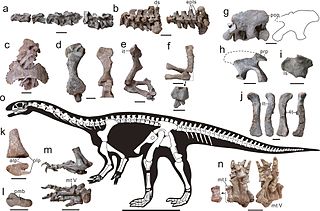
Xingxiulong is a genus of bipedal sauropodiform from the Early Jurassic of China. It contains a single species, X. chengi, described by Wang et al. in 2017 from three specimens, two adults and an immature individual, that collectively constitute a mostly complete skeleton. Adults of the genus measured 4–5 metres (13–16 ft) long and 1–1.5 metres tall. Phylogenetic analysis suggests that Xingxiulong is most closely related to its contemporary Jingshanosaurus, although an alternative position outside of both the Sauropodiformes and Massospondylidae is also plausible.
Shuangbaisaurus is genus of theropod dinosaur, possibly a junior synonym of Sinosaurus. It lived in the Early Jurassic of Yunnan Province, China, and is represented by a single species, S. anlongbaoensis, known from a partial skull. Like the theropods Dilophosaurus and Sinosaurus,Shuangbaisaurus bore a pair of thin, midline crests on its skull. Unusually, these crests extended backwards over the level of the eyes, which, along with the unusual orientation of the jugal bone, led the describers to name it as a new genus. However, Shuangbaisaurus also possesses a groove between its premaxilla and maxilla, a characteristic which has been used to characterize Sinosaurus as a genus. Among the two morphotypes present within the genus Sinosaurus, Shuangbaisaurus more closely resembles the morphotype that is variably treated as a distinct species, S. sinensis, in its relatively tall skull.
